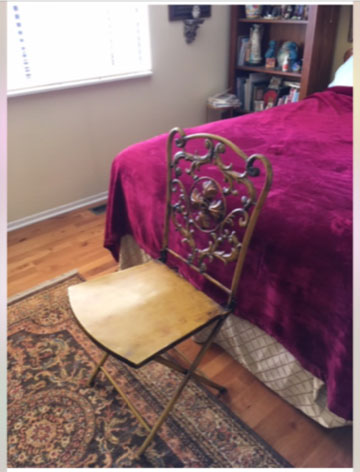 JT sent me photos of two antique metal folding chairs. She uses them for conversation starters in her bedroom. She picked them up for $10 each at a thrift store and wants to know their original function.
JT sent me photos of two antique metal folding chairs. She uses them for conversation starters in her bedroom. She picked them up for $10 each at a thrift store and wants to know their original function.
They appear either French or American French Revival 1870-1880. Made in the X form, with wrought iron that frames the backs with a curved crest rail. The framed backs act as support for the central design of a quatrefoil framed with flaming arabesques. The design is made of pierced repoussé metal. The seat is absolutely flat, a tortuous looking sheet of metal. JT said they feel quite heavy.
19th Century Ballroom Chairs
JT found no maker’s marks. But because of their ‘dressy’ decoration, although heavier, I believe they came from a late 19th century suite of ballroom chairs. More likely somebody commissioned them for a private ballroom where the painted walls ‘matched’ the designs on the backs of the chairs.
Folding or not, ballroom chairs, a tradition since the 18th century, are still used today. Any large wedding features indomitable gold spindle back chairs, too narrow for most rear ends. I myself have an antique example in my expensive storage unit, a very small delicate wooden ballroom chair from the 19th century. In the better days I used it as a spare at the head of my dining table, where I squeezed in one more guest in the spindly chair. I laugh to remember that usually the heftiest and tallest of my friends chose that chair. It exhibits the dressy look of all ballroom chairs, never any arms and narrow, befitting the gowns and the tailcoats of the period.
A Sign of a Wealthy Family
Some people call the ballroom beauties of the period “music box” chairs. Wealthy families often set the chairs out for concerts in their music salon. Many guests brought pillows for their backsides. In fact the narrowness of the chairs led to much flirting. Many famous period style Hollywood movies feature dalliances upon such narrow perches which forced people together for hours. Event chairs were used only at the time of the event, then retired, sometimes lined up against the walls or stored in the outbuildings. One’s staff handled that, of course.
JT’s are metal, rare and probably thought extravagant when commissioned. Metal seating furniture, unlike today, was then a novelty. Ballroom chairs were usually made in lightweight materials, even Papier Mache. They are always uncomfortable, as the object of the exercise of sitting upon one of these is seen, thus the seats are lightly padded if any padding exists. The backs are very straight. Any upholstery on the seats was never sprung or raised or filled. Usually it consisted of fabric stretched over a board, called a slip seat with no bolsters or tufting.
Because people associated the chairs with a formal event, and brought them out exclusively for the event, they often appear ornamented. We see on JT’s that fancy repouse back, some have Mother of Pearl accents, some have bronze mounts. The wood is generally treated with a shine, some giltwood (bight shiny gold) or ebonized (deep shiny black).
It’s All in the Decor
Families usually commissioned ballroom chairs in styles that complemented the total décor of the ballroom. In the last quarter of the 19th century they usually chose French, as many lived in Newport mansions. For these rooms, families commissioned Louis XVI style straight side chairs with slim straight backs and caned seat. Those chairs usually came painted a pastel color.
JT’s chair folds. But if she thinks the folding chair a 19th century invention, a folding chair was found by Lord Carnarvon and Carter in Tutankhamun’s tomb (1324BC). Another was found in Denmark, the famed Nordic Bronze age Guldhoj Chair (1350 BC). Middle Age Priests sat upon folding chairs, some quite tall and grand, with head rests and arms. But yes, the X form folding chair was patented by American John Cram (1855). Those ubiquitous folding aluminum chairs that felt so cold and conversely burning hot in the summer on the bum were patented by Fredric Arnold of Brooklyn in 1947.
The value of JT’s chairs is $150 each.